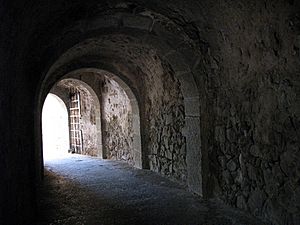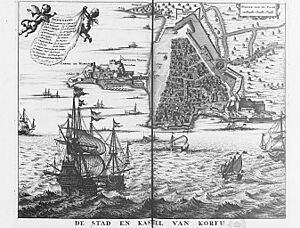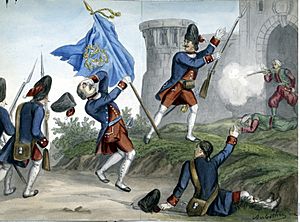Ottoman–Venetian War (1714–1718) facts for kids
Quick facts for kids Seventh Ottoman–Venetian War |
|||||||||
|---|---|---|---|---|---|---|---|---|---|
| Part of the Ottoman–Venetian wars and the Ottoman–Portuguese confrontations | |||||||||
 Dante’s Gate in Spinalonga fort, the last remaining Venetian outpost on Crete |
|||||||||
|
|||||||||
| Belligerents | |||||||||
Hajduks |
|||||||||
| Commanders and leaders | |||||||||
| Casualties and losses | |||||||||
The Seventh Ottoman–Venetian War was a big conflict between the Republic of Venice and the Ottoman Empire. It lasted from 1714 to 1718. People also called it the Second Morean War or the Small War. In Croatia, it was known as the War of Sinj. This was the last major fight between these two powers. The war ended with the Ottomans winning. Venice lost its important land in Greece, called the Peloponnese (also known as Morea). Luckily, Austria stepped in to help Venice in 1716. Austria's victories led to a peace agreement called the Treaty of Passarowitz in 1718, which ended the war.
Contents
Why the War Started
After the Ottoman Empire lost a big battle at Vienna in 1683, many European countries formed an alliance. This alliance was called the Holy League. They fought against the Ottomans in a conflict known as the Great Turkish War (1683–1699). The Ottomans lost several battles and had to give up a lot of land.
The Republic of Venice also joined this fight. They wanted to get back lands the Ottomans had taken from them. Venice managed to capture the island of Lefkada in 1684. They also took the Peloponnese peninsula between 1685 and 1687. In the Treaty of Karlowitz (1699), Venice kept control of the Peloponnese and another island called Cephalonia.
The Ottomans were very unhappy about losing the Peloponnese. This area was important to them, especially for its income. They wanted to take it back. For many years, there were tensions between Venice and the Ottomans. Venice's control over the Peloponnese was weak. They had only a few thousand soldiers there. These soldiers often had problems with supplies and morale.
Meanwhile, the Ottomans improved their navy. Venice, on the other hand, became more isolated from other European countries. Many European states were busy with other wars. The Ottomans saw this as a good chance to attack Venice. They had just won a war against Russia in 1710–1711. This victory made them feel confident.
They found a reason to declare war. Venice had seized an Ottoman ship with valuable treasures. Also, Venice gave safety to a leader from Montenegro who had rebelled against the Turks. So, on December 9, 1714, the Ottoman Empire declared war on Venice.
Ottoman Victory in the Morea
In early 1715, the Ottomans gathered a large army of about 70,000 soldiers. This army was led by Silahdar Damat Ali Pasha. On May 22, the army marched south. They arrived at Thebes on June 9. Some reports say the army had over 110,000 men in total for the campaign.
After a meeting on June 13, 15,000 soldiers were sent to capture Lepanto. The main army moved towards the Isthmus of Corinth. They aimed for two important Venetian forts: Acrocorinth and Nauplia. At the same time, the Ottoman navy, with 80 warships, captured the islands of Tinos and Aigina.
The Venetians had a much smaller force. They had only about 8,000 soldiers and 42 small ships. Their commander was Daniel Delfin. This force was not enough to fight the large Ottoman army. It was also too small to defend all the forts Venice had built. The local Greek people did not like Venetian rule. The Ottoman leader, Damat Ali, made sure his soldiers treated the Greeks well. This made the Greeks friendly towards the Ottomans. They helped the Ottoman army with supplies. The Venetians, however, were left alone in their forts.
On June 25, the Ottoman army entered the Peloponnese. The fort of Acrocorinth, which controlled the way into the peninsula, gave up quickly. The Venetians were promised safe passage. However, some Ottoman soldiers ignored orders and attacked the fort. Many Venetian soldiers and civilians were killed or sold into slavery. Only 180 Venetians were saved and sent to Corfu.
After Corinth, the Ottomans attacked Nauplia (Napoli di Romagna). This was Venice's main base in the Peloponnese. Nauplia was well-protected by strong forts and had 2,000 soldiers. But on July 20, after only nine days of fighting, the Ottomans blew up a part of the fort. They successfully stormed the fort. The Venetian defenders panicked and ran away.
The Ottomans then moved southwest. The forts of Navarino and Koroni were left by the Venetians. The remaining Venetian forces gathered at Methoni (Modon). But the Venetian navy did not help them from the sea. So, the fort surrendered. Other Venetian strongholds, including the last ones on Crete (Spinalonga and Souda), also gave up. They were allowed to leave safely. In just one hundred days, the Ottomans had taken back the entire Peloponnese.
The Ottoman campaign was very successful. Even though Venice had enough supplies, their soldiers were weak. The Venetian government could not pay for the war. The Ottomans had many more soldiers. They were also willing to accept many losses. For example, 8,000 Ottoman soldiers were killed and 6,000 wounded during the nine-day siege of Nauplia. Also, the Ottoman navy helped a lot this time. They brought large cannons to help with the siege of Nauplia.
On September 13, the Ottoman leader began his journey back home. He was praised by the Sultan. There were parades and celebrations. By October 10, the campaign was officially over. The Grand Vizier returned to the capital in triumph on December 2.
The Siege of Corfu
After taking back the Peloponnese, the Ottomans attacked the Ionian Islands that Venice still held. They captured the island of Lefkada and the fort of Butrinto. On July 8, 1716, an Ottoman army of 33,000 men landed on Corfu. Corfu was the most important of the Ionian Islands. Even though there was a sea battle that day, the Ottoman army continued to land. They moved towards the city of Corfu. On July 19, after taking some smaller forts, the siege of Corfu began.
Count Johann Matthias von der Schulenburg led the defense of Corfu. He had about 8,000 men. The strong forts and the brave defenders held off several attacks. On August 9, a big storm hit. The defenders believed it was a miracle from Corfu's patron saint, Saint Spyridon. The storm caused many problems for the Ottoman attackers. The siege was called off on August 11. The last Ottoman forces left on August 20.
Austria Steps In
In the summer of 1715, an Ottoman army attacked Venetian lands in Dalmatia. This army reportedly had 40,000 men. The Ottomans were defeated in a siege of Sinj. But this threat to Dalmatia helped convince Austria to get involved in the war.
Pope Clement XI gave money to help. France promised to protect Austria's lands in Italy. So, Austria felt ready to join the fight. On April 13, 1716, Emperor Charles VI renewed his alliance with Venice. Because of this, the Ottomans declared war on Austria.
The Austrian threat made the Ottomans move their forces away from Venice's remaining lands. But Venice was too weak to launch any big attacks. Only its navy became more active. There were sea battles between the Venetian and Ottoman fleets in the Aegean Sea. These included the Battle of Imbros and the Battle of Matapan. But these battles did not decide the war's outcome. Venice's only lasting success was capturing the forts of Preveza and Arta in 1717.
However, Austria won important victories at the Battle of Petrovaradin and the Siege of Belgrade. These wins forced the Ottomans to sign the Treaty of Passarowitz. The Ottomans lost a lot of land to Austria. But they kept the lands they had conquered from Venice in the Peloponnese and Crete. Venice only got back Preveza and a few forts in Herzegovina.
What Happened Next
After the war, the Republic of Venice became less powerful. It was no longer a major player in international politics. It became more like a state that depended on the Habsburgs. This continued until Venice was abolished in 1797.
Sources
- Anderson, R. C. (1952). Naval Wars in the Levant 1559–1853. Princeton: Princeton University Press. OCLC 1015099422. https://hdl.handle.net/2027/mdp.39015005292860.
- Chasiotis, Ioannis (1975). "Η κάμψη της Οθωμανικής δυνάμεως". In Christopoulos, Georgios A. (in Greek). Ιστορία του Ελληνικού Έθνους, Τόμος ΙΑ΄: Ο Ελληνισμός υπό ξένη κυριαρχία (περίοδος 1669 - 1821), Τουρκοκρατία - Λατινοκρατία. Athens: Ekdotiki Athinon. pp. 8–51. ISBN 978-960-213-100-8.
See also
 In Spanish: Guerra turco-veneciana (1714-1718) para niños
In Spanish: Guerra turco-veneciana (1714-1718) para niños



